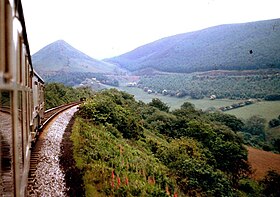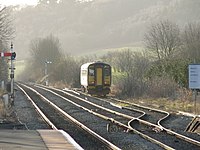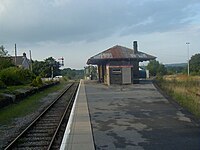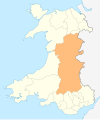Heart of Wales line
| Heart of Wales line | |||
|---|---|---|---|
 The Heart of Wales line south ofSugar Loaf | |||
| Overview | |||
| Other name(s) | Heart of Wales Railway Rheilffordd Calon Cymru | ||
| Native name | Llinell Calon Cymru(Welsh) | ||
| Owner | Network Rail | ||
| Locale | South West Wales Mid Wales Shropshire | ||
| Termini | |||
| Stations | 29 | ||
| Service | |||
| Type | Heavy rail | ||
| System | National Rail | ||
| Operator(s) | Transport for Wales Rail | ||
| Rolling stock | Class 150 DMU, Class 153 DMU | ||
| History | |||
| Opened | 1868 | ||
| Technical | |||
| Line length | Craven Arms–Llanelli 90 mi (144.84 km) Shrewsbury–Swansea 121 mi (194.73 km) | ||
| Number of tracks | Mainlysingle track | ||
| Character | Rural | ||
| Track gauge | 4 ft8+1⁄2in(1,435 mm)standard gauge | ||
| Operating speed | 60 mph (97 km/h) (max) | ||
| |||
Heart of Wales line | ||||||||||||||||||||||||||||||||||||||||||||||||||||||||||||||||||||||||||||||||||||||||||||||||||||||||||||||||||||||||||||||||||||||||||||||||||||||||||||||||||||||||||||||||||||||||||||||||||||||||||||||||||||||||||||||||||||||||||||||||||||||||||||||||||||||||||||||||||||||||||||||||||||||||||||||||||||||||||||||||||||||||||||||||||||||||||||||||||||||||||||
|---|---|---|---|---|---|---|---|---|---|---|---|---|---|---|---|---|---|---|---|---|---|---|---|---|---|---|---|---|---|---|---|---|---|---|---|---|---|---|---|---|---|---|---|---|---|---|---|---|---|---|---|---|---|---|---|---|---|---|---|---|---|---|---|---|---|---|---|---|---|---|---|---|---|---|---|---|---|---|---|---|---|---|---|---|---|---|---|---|---|---|---|---|---|---|---|---|---|---|---|---|---|---|---|---|---|---|---|---|---|---|---|---|---|---|---|---|---|---|---|---|---|---|---|---|---|---|---|---|---|---|---|---|---|---|---|---|---|---|---|---|---|---|---|---|---|---|---|---|---|---|---|---|---|---|---|---|---|---|---|---|---|---|---|---|---|---|---|---|---|---|---|---|---|---|---|---|---|---|---|---|---|---|---|---|---|---|---|---|---|---|---|---|---|---|---|---|---|---|---|---|---|---|---|---|---|---|---|---|---|---|---|---|---|---|---|---|---|---|---|---|---|---|---|---|---|---|---|---|---|---|---|---|---|---|---|---|---|---|---|---|---|---|---|---|---|---|---|---|---|---|---|---|---|---|---|---|---|---|---|---|---|---|---|---|---|---|---|---|---|---|---|---|---|---|---|---|---|---|---|---|---|---|---|---|---|---|---|---|---|---|---|---|---|---|---|---|---|---|---|---|---|---|---|---|---|---|---|---|---|---|---|---|---|---|---|---|---|---|---|---|---|---|---|---|---|---|---|---|---|---|---|---|---|---|---|---|---|---|---|---|---|---|---|---|---|---|---|---|---|---|---|---|---|---|---|---|---|---|---|---|---|---|---|---|
| ||||||||||||||||||||||||||||||||||||||||||||||||||||||||||||||||||||||||||||||||||||||||||||||||||||||||||||||||||||||||||||||||||||||||||||||||||||||||||||||||||||||||||||||||||||||||||||||||||||||||||||||||||||||||||||||||||||||||||||||||||||||||||||||||||||||||||||||||||||||||||||||||||||||||||||||||||||||||||||||||||||||||||||||||||||||||||||||||||||||||||||
TheHeart of Wales line(Welsh:Llinell Calon Cymru)[1]is arailway linerunning fromCraven ArmsinShropshiretoLlanelliinsouthwestWales.It serves a number of rural centres, including the nineteenth-centuryspa townsLlandrindod Wells,Llangammarch WellsandLlanwrtyd Wells.AtBuilth Road,two miles (3.3 km) from the town ofBuilth Wells,the line crosses the former route of the earlierMid Wales Railway,which closed in 1962.
History[edit]


Historically, the line was known as theCentral Wales line(Welsh:Rheilffordd Canol Cymru)[nb 1]and also included routes throughGowerton,where the railway crossed theWest Wales linesand ran throughDunvantandKillaythen down through the Clyne Valley toBlackpill,and then along the sea wall toSwansea Bay station,(near the former slip bridge) before finally reachingSwansea Victoria railway station.This section, originally built by theLlanelly Railway and Dock Companyto compete with theGreat Western Railwayand break the monopoly they held on Swansea Dock, closed in 1964.Nationalisationof the railways had removed the need for competing routes, and the running down and closure of Swansea North Dock ended the need for freight services on this section. Trains now use the original LR main line to reach theWest Wales linesatLlandeilo Junctionand thenceLlanelliand (after a reversal)Swansea.
North ofLlandovery,the route was opened in stages between 1861 and 1868 by a number of different companies (all backed by theLNWR) – theKnighton Railway,theCentral Wales RailwayandCentral Wales Extension Railway.
The 1963 Beeching Report proposed the entire Central Wales line be closed but this was refused by the MoT except for the Pontarddulais to Swansea Victoria section.[2]As a rural branch line, it survived theBeeching Axesince it carried freight traffic, serving the steelworks atByneaand industrial areas such asAmmanfordandPontarddulais,linking them with the docks atLlanelli.It also passed through sixmarginal constituencies.[3]During engineering work, the line is still occasionally used as a diversionary freight route. The basic service over the line since the seventies has remained more or less constant, with four or five trains per day in each direction on weekdays and two or three on Sundays (although the latter ran in summer only until quite recently).
The line is single track throughout (except for a few miles at the southern end shared with theSwansea District line) and has been operated under aLight Railway Ordersince 1972.[4]There are fivepassing loops,atLlandeilo,Llandovery,Llanwrtyd,LlandrindodandKnighton.Unless "Out of Course" working occurs the Llanwrtyd passing loop is used on two of the Monday – Saturday services and the Llandrindod passing loop is in use on the other two and also on the Sunday services. The signalling was modernised in 1986,[5]when a system known asNo Signalman Token Remoteworking was introduced.[6]This is overseen by the signaller atPantyffynnon,with the token instruments at the aforementioned five passing loops being operated by the train crew (the survivingsignal boxesat each station having been closed as part of the modernisation scheme and the points converted to automatic operation byBritish Rail).
For more than two years only two of the loops (Llandrindod and Llanwrtyd) were operational asNetwork Railwere unable to source spare parts for the points mechanisms used at all five: the design used is now obsolete. Parts had to be taken from the three decommissioned loops to keep the other two operational.[7]In 2009 NR stated their intention to install new conventional electric point machines at all five loops and restore the three out-of-service ones to full working order (after being heavily criticised by the chairman of the South Wales branch ofRailfutureat the organisation's recent Annual General Meeting)[8]but were unable to give a timescale for this to be carried out as design work on the new equipment was still ongoing. NR began the replacement works for the points after first installing the system on the line to Pembroke Dock, at the Tenby loop, on 7 December 2009 and then making minor alterations in Feb 2010.Llandeilowas the first on the line to be modernised, the rest followed. The £5 million project was completed in October 2010.[9]
In 2014 Network Rail added exit indicators at the trailing end of each loop to aid in the reversing of services: a decision taken so that all moves have an active indication of the status of the motor points.
In 1987 tragedy struck the line nearLlandeilowhen theGlanrhyd Bridge collapsedfollowing heavy flooding, and an early morning northbound train plunged into the swollenRiver Towy,killing four people.[10]For a while the future of the line was in doubt (the equally ruralCarmarthen-Aberystwyth linehad been closed in 1965 following serious flood damage as the cost of repairs was deemed unacceptable) but political forces of all sides rallied to ensure the line's survival.
Route[edit]
After leaving theWest Wales LineatLlandeilo Junction(east ofLlanelli), the route is shared with the Swansea District line as far asMorlais Junction(the site of a seriousoil train derailmentin the summer of 2020) before passing beneath theM4 Motorway,and turning northwards towardsPontarddulaisand Pantyfynnon. The short tunnel before the former station is the oldest surviving example still in use in Wales (dating from 1839), whilst the freight-only branch along the Amman valley toGwaun-Cae-Gurwendiverges at the latter. North ofAmmanford,it follows the valley of theRiver Tywinorth to Llandeilo (formerly the junction forCarmarthen) and thenLlandovery,crossing the river at Glanrhyd by a replacement single-span bridge built & commissioned in 1988. North of Llandovery the character of the route changes, as it ascends into theCarmarthenshirehills towards the first of the line's two major summits atSugar Loaf(820 feet (250 m) above sea level) on gradients as steep as 1 in 60.[11]En route, it passes over the 283-yard (259 m) longCynghordyviaduct across the Afon Bran valley before crossing the county boundary intoPowysthrough the 1001-yd (915 m) summit tunnel beneath theBlack Mountainrange. A descent at 1 in 70-80 follows toLlanwrtyd Wellsalong the valley of theRiver Irfon,from where it continues via Builth Road to Llandrindod Wells - the largest settlement on the line.
From Llandrindod, the line climbs steadily once more, skirting theRadnor Forestas it heads for the remote station atLlanbister Road(some 5 miles (8 km) distant from the village it is named after) and another summit nearLlangynlloTunnel, the highest point on the route at 980 feet (299 m) above sea level. There then follows a 4-mile (6.4 km) descent (again at mostly 1 in 60) toKnucklas,where the line is carried above the village on a 193-yd (176 m) viaduct with ornate castellated turrets at each end. It then heads toKnighton,where the station is in England but the town it serves is in Wales.[11]The last portion of the route then runs through southwestShropshirealong the valleys of theRiver Teme&River Clunto join the main Shrewsbury to Hereford line atCraven Arms.
Services today[edit]

Passenger services[edit]
For many years there were four trains per day in each direction on weekdays and two on Sundays. From May 2015 an additional Monday to Friday train pair in each direction was introduced north ofLlandrindodand south ofLlandovery,ostensibly to improve commuting possibilities, although the consequential changes to existing services substantially lengthened the working day for those travelling toShrewsbury.[12]Trains are one or two carriages each, with a small team of staff. A buffet trolley service runs occasionally.[when?]The Heart of Wales line runs from Llanelli to Craven Arms, however train services normally terminate atShrewsburyandSwansea.Two northbound weekday trains travel onwards from Shrewsbury toCrewe,bringing the total journey length to 153.5 miles (247.03 kilometres), and one starts from Crewe southbound. Most stations arerequest stops. From December 2022 a fifth train through train each way has been introduced as well as a later Shrewsbury-Llandrindod round trip and a late Swansea - Llandovery out and return service on weekdays only.
At Craven Arms, the line joins theWelsh Marches linetoChurch StrettonandShrewsbury.
Passenger services are operated byTransport for Wales RailusingClass 150orClass 153diesel multiple units,althoughClass 175shave been used on rare occasions.[citation needed]The continued use of Class 153 DMUs has received criticism, notably fromKirsty Williams AM,who says:
The 153 units have a poor reliability record, can carry few bicycles—which we desperately need to be carried on the line—little bulky luggage, and offer poor visibility, and this on a line that is supposedly promoted as scenic.[13]
The line has also been used for exceptional train movements, including:
- ManchestertoCarmarthentrains diverted during engineering works betweenBriton FerryandBridgend
- Builth Roadhas special trains fromCardifffor theRoyal Welsh Showwhich operate via theSwansea District linebetweenBriton FerryandPontarddulais
- Charter trains taking in the scenic beauty of the route, such as The Welshman's charter on Saturday 30 April 2011

Freight services[edit]
Although no regular scheduled freight services use this line, the route is maintained to W5 standard to accommodate the occasional EWS diversions for Margam and Llanwern traffic when the south Wales route is closed.
Community rail[edit]
This is designated as acommunity railpartnership.[14]
See also[edit]
Notes[edit]
- ^Network Railstill uses the name for the line,in an infrastructure sense.
References[edit]
- ^"TfW Network Map"(PDF).Transport for Wales.Retrieved8 December2021.
- ^Dunn, J.M. (May 1964). "Welsh Reprieve, part one".Railway Magazine.Vol. 110, no. 757. pp. 404–412.
- ^Morgan, Kenneth O.(1981).Rebirth of a Nation: Wales, 1880-1980.Oxford University Press. p. 329.ISBN978-0-19-821736-7.
- ^Central Wales Railway Light Railway (Amendment) Order 1990www.opsi.gov.uk; Retrieved 2003-03-02
- ^NSTR Signallingwww.railsigns.co.uk; retrieved 2009-02-27
- ^Clift, Tom (June 1987). "The Shortest and Most Expeditious Route".The Railway Magazine.No. 1034. pp. 380–381.
- ^News Article in RAIL Magazine, Issue 614, p.15
- ^Heart of Wales Line In DangerArchived2012-10-05 at theWayback MachineWales Online; Retrieved 2009-03-28
- ^News Article in RAIL Magazine, Issue 656, p.19
- ^"Glanrhyd disaster: Memories of train tragedy 30 years on".BBC News.19 October 2017.
- ^ab"Heart of Wales Railway"Doughty, Audrey,Llandeilo Past & Present
- ^Table 129National Railtimetable, May 2015
- ^Developing the Heart of Wales Line– Speech by Kirsty Williams AM on Wed 16th Nov 2005 – archived fromoriginal
- ^"ACORP Summary map"(PDF).Association of Community Rail Partnerships. 28 July 2014. Archived fromthe original(PDF)on 18 November 2015.Retrieved28 October2015.




